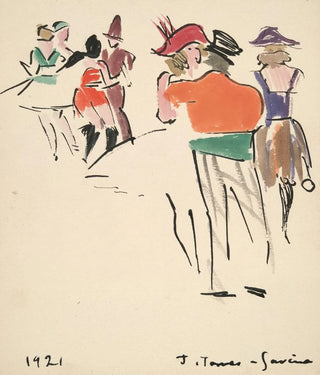Art print | Bal des Artistes Danseurs costumés - Joaquín Torres-García


View from behind

Frame (optional)
Bal of Costumed Dancers Art print - Joaquín Torres-García – Captivating introduction
In the vibrant world of modern art, "Bal of Costumed Dancers" by Joaquín Torres-García stands out for its boldness and visual richness. This piece, which evokes a celebration of creativity and imagination, immerses us in a world where dance and costume intertwine to bring to life an effervescent festival. The artist, through his unique approach, manages to capture the very essence of artistic expression, inviting us to share a moment of joy and conviviality. Through this art print, every detail, every color, every movement is carefully reproduced, allowing the viewer to feel the energy and passion emanating from this scene.
Style and uniqueness of the work
Torres-García's style in "Bal of Costumed Dancers" is both playful and complex. He combines geometric shapes with figurative elements, creating a visual language that is entirely his own. The vibrant colors, often boldly juxtaposed, inject a dynamic quality into the entire composition. The piece does not merely depict a dance scene; it also provokes reflection on art itself, on the creative process, and on the role of the artist in society. The figures, though stylized, express a multitude of emotions, ranging from joy to melancholy, and each dancer seems to tell a unique story. This ability to fuse abstraction and figuration is what gives the work its singularity and undeniable appeal.
The artist and his influence
Joaquín Torres-García, an emblematic figure of Latin American modern art, knew how to leave his mark on his era with an innovative vision. Originating from Uruguay, he developed a style that blends European influences with South American traditions. His quest for an authentic artistic identity led him to explore various mediums, from painting to sculpture. Torres-García was also a passionate advocate for educational art, firmly believing that art should be accessible to all. His influence is still felt today, both through his works and through the many

Matte finish

View from behind

Frame (optional)
Bal of Costumed Dancers Art print - Joaquín Torres-García – Captivating introduction
In the vibrant world of modern art, "Bal of Costumed Dancers" by Joaquín Torres-García stands out for its boldness and visual richness. This piece, which evokes a celebration of creativity and imagination, immerses us in a world where dance and costume intertwine to bring to life an effervescent festival. The artist, through his unique approach, manages to capture the very essence of artistic expression, inviting us to share a moment of joy and conviviality. Through this art print, every detail, every color, every movement is carefully reproduced, allowing the viewer to feel the energy and passion emanating from this scene.
Style and uniqueness of the work
Torres-García's style in "Bal of Costumed Dancers" is both playful and complex. He combines geometric shapes with figurative elements, creating a visual language that is entirely his own. The vibrant colors, often boldly juxtaposed, inject a dynamic quality into the entire composition. The piece does not merely depict a dance scene; it also provokes reflection on art itself, on the creative process, and on the role of the artist in society. The figures, though stylized, express a multitude of emotions, ranging from joy to melancholy, and each dancer seems to tell a unique story. This ability to fuse abstraction and figuration is what gives the work its singularity and undeniable appeal.
The artist and his influence
Joaquín Torres-García, an emblematic figure of Latin American modern art, knew how to leave his mark on his era with an innovative vision. Originating from Uruguay, he developed a style that blends European influences with South American traditions. His quest for an authentic artistic identity led him to explore various mediums, from painting to sculpture. Torres-García was also a passionate advocate for educational art, firmly believing that art should be accessible to all. His influence is still felt today, both through his works and through the many






